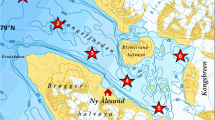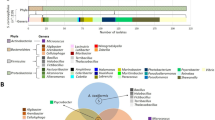Abstract
Mineralization of organic matter in anaerobic environments is accomplished by a community of physiologically different bacteria.1 Biogenic polymers such as carbohydrates and proteins are hydrolyzed and the monomers produced are subsequently converted to a variety of products by fermentative bacteria. Their fermentation products are further oxidized by sulfate-reducing bacteria or by syntrophic consortia of acetogenic and methanogenic bacteria. Our knowledge of anaerobic polysaccharide degrading communities mainly originates from the cellulolytic system in the rumen2,3,4 Much less is known about the microbiology of anaerobic polysaccharide composition in marine environments. This is particularly true for the structure of these communities and the possible interspecies interaction involved (i.e. the primary hydrolysing bacteria and those using hydrolysis and fermentation products).
Access this chapter
Tax calculation will be finalised at checkout
Purchases are for personal use only
Preview
Unable to display preview. Download preview PDF.
Similar content being viewed by others
References
H. J. Laanbroek and H. Veldkamp, Microbial interactions in sediment communities. Phil. Trans. R. Soc. Lond. B 297:550 (1982).
R. E. Hungate, “The rumen and its microbes”, Academic Press, New York (1966).
H. D. Peck Jr. and M. Odom, Anaerobic fermentations of cellulose to methane, in: “Basic Life Sciences” vol. 18, Trends in the biology of fermentations for fuels and chemicals. A. Hollaender, ed., Plenum Press (1981).
N. O. van Gylswyk and H. M. Schwarz, Microbial ecology of cellulose and hemicellulose metabolism in gastro-intestinal ecosystems, in: “Current perspectives in microbial ecology”, M. J. Klug and C. A. Reddy, eds., American Society for Microbiology, Washington (1983).
F. Colijn, Primary production in the Ems-Dollard estuary, Thesis University of Groningen, The Netherlands (1983).
Invertebrates of the Wadden Sea, Final report of the section “Marine Zoology” of the Wadden Sea working group, N. Dankers, H. Kühl and W. J. Wolff, eds., (1981).
K. Timmis, G. Hobbs, and R.C.W. Berkeley, Chitinolytic Clostridia isolated from mud. Can. J. Microbiol. 20:1284 (1974).
R. C. W. Berkeley, in. Berkeley, in: “Microbial polysaccharides and polysaccharases”, R. C. W. Berkeley, G. W. Gooday and D. C. Ellwood, eds., Special Publ. SGM: 3, Academic Press, (1979).
P.E. Guire, Fractionation of oligosaccharides by polyacrylamide gel filtration, Proc. Okla. Acad. Sci. 51:63 (1971).
H.J. Laanbroek, H.J. Geerligs, A.A. C.M. Peijnenburg, and J. Siesling, Competition for L-lactate between Desulfovibrio, Veillonella and Acetobacterium species isolated from anaerobic intertidal sediments, Microb. Ecol. 9:341 (1983).
H.J. Laanbroek, H.J. Geerligs, L. Sijtsma, and H. Veldkamp, Competition for sulfate and ethanol among Desulfobacter, Desulfobulbus and Desulfovibrio species isolated from intertidal sediments, Appl. Environm. Microbiol. 47:329 (1984).
H. G. Trüper and H. G. Schlegel, Sulphur metabolism in Thiorhodacea. Quantitative measurements on growing cells of Chromatium okenii. Antonie van Leeuwenhoek 30: 225 (1964).
G.C. Chen and B.R. Johnson, Improved colorimetric determination of cell wall chitin in wood decay fungi, Appl. Environ. Microbiol. 46:13 (1983).
M. V. Tracey, Chitin, in: “Modern methods of plant analysis”, K.Paech and M. V. Tracey, eds., Springer, Berlin (1955).
K. Blumberg, F. Liniere, L. Prestilnik, and C.A. Bush, Fractionation of oligosaccharides containing N-acetylamino sugars by reversephase hugh-pressure liquid chromatography. Anal. Biochem. 119:407–412 (1982)
N. Aï, N. Creuzet, and J. Cattaneo, Properties of ß-glucosidase purified from Clostridium thermocellum, J. Gen. Microbiol. 128:569 (1982).
E. A. Johnson and A. E. Demain, Probable involvement of sulfhydryl groups and a metal as essential components of the cellulase of Clostridium thermorellum, Arch. Microbiol. 137:135 (1984).
C. W. Forsberg and D. Grolean, Stability of the endo-ß-1,4-gluconase and ß-1,4-glucosidase from Bacteroides succinogenes, Can. J. Microbiol. 28:144 (1982).
C. Giuliano and A. W. Khan, Cellulase and sugar formation by Bacteroides cellulosolvers, a newly isolated cellulolytic anaerobe, Appl. Environ. Microbiol. 48:446. (1984).
B. Schink and M. Stieb, Fermentative degredation of polyethylene glycol by a strictly anaerobic, gram-negative, nonspore-forming bacterium, Pelobacter venetianus sp. nov., Appl. Environ. biol. 45:1905 (1983).
B. Schink and J.G. Zeikus, Clostridium thermosulfurogenes sp. nov., a new thermophile that produces elemental sulphur from thiosulphate, J. Gen. Microbiol. 129:1149 (1983).
T.K. Ng and J.G. Zeikus, Differential metabolism of cellobiose and glucose by Clostridium thermohydrosulfuricum, J. Bacteriol. 150:1391 (1982).
M.C. Fasee and J. M. Leatherwood, Regulation of cellulase from Rumminococcus, Can. J. Microbiol. 18:347 (1972).
Author information
Authors and Affiliations
Editor information
Editors and Affiliations
Rights and permissions
Copyright information
© 1986 Plenum Press, New York
About this chapter
Cite this chapter
Pel, R., Gottschal, J.C. (1986). Chitinolytic Communities From an Anaerobic Estuarine Environment. In: Muzzarelli, R., Jeuniaux, C., Gooday, G.W. (eds) Chitin in Nature and Technology. Springer, Boston, MA. https://doi.org/10.1007/978-1-4613-2167-5_64
Download citation
DOI: https://doi.org/10.1007/978-1-4613-2167-5_64
Publisher Name: Springer, Boston, MA
Print ISBN: 978-1-4612-9277-7
Online ISBN: 978-1-4613-2167-5
eBook Packages: Springer Book Archive




